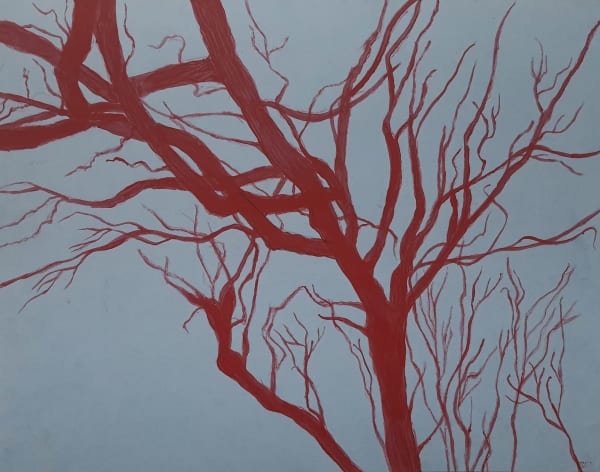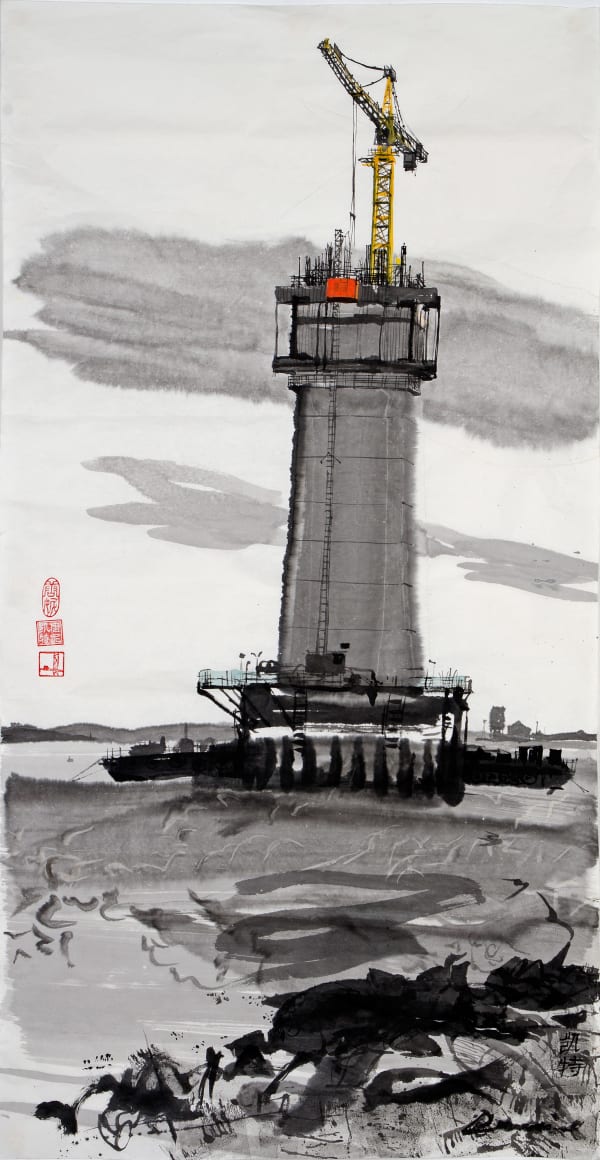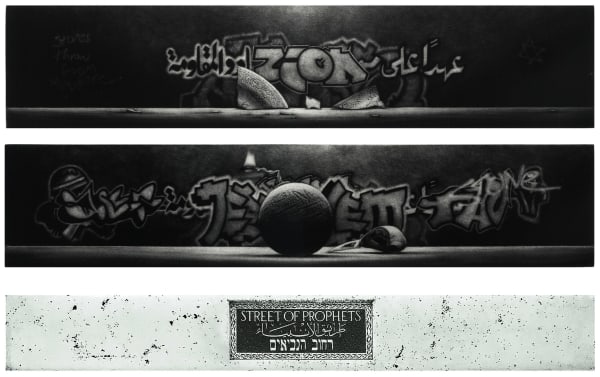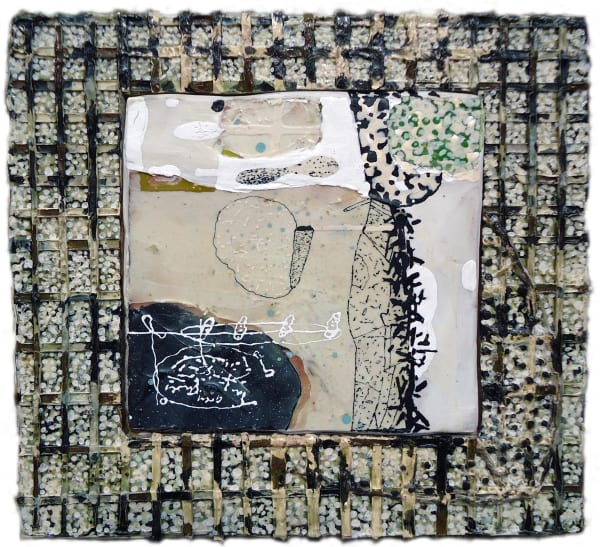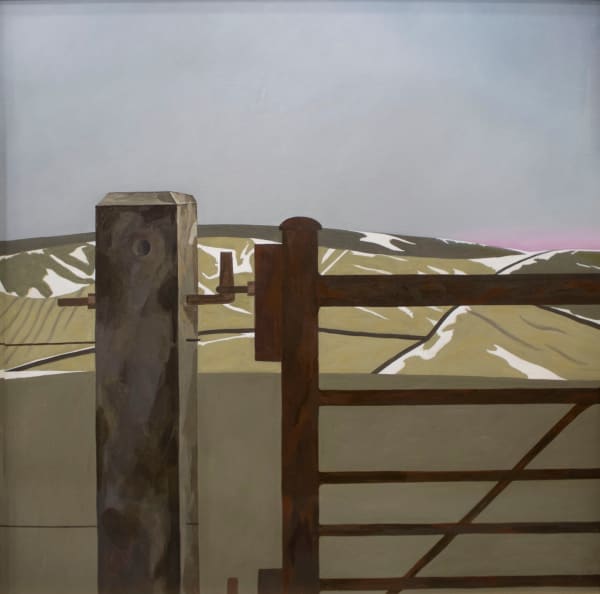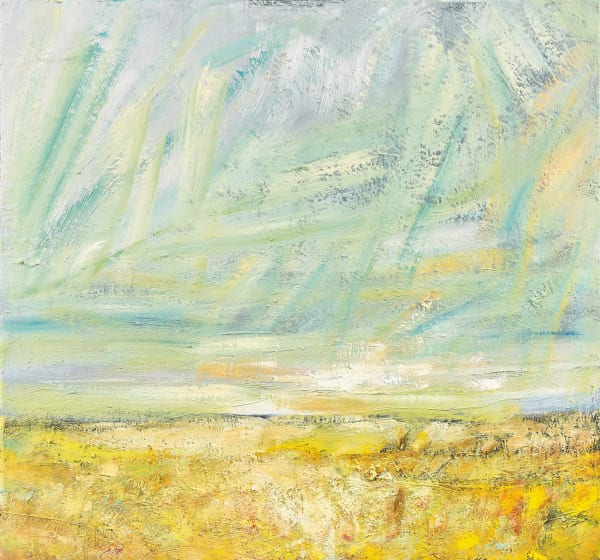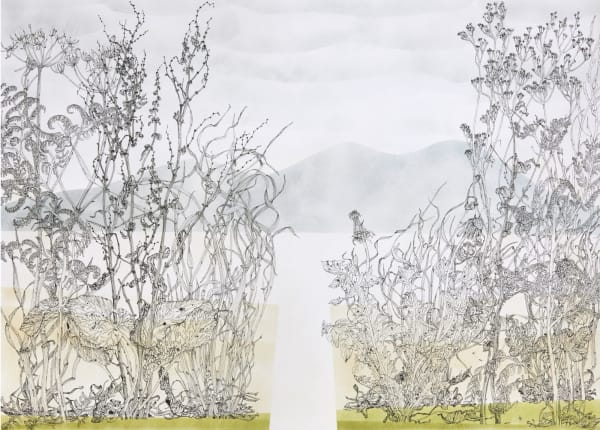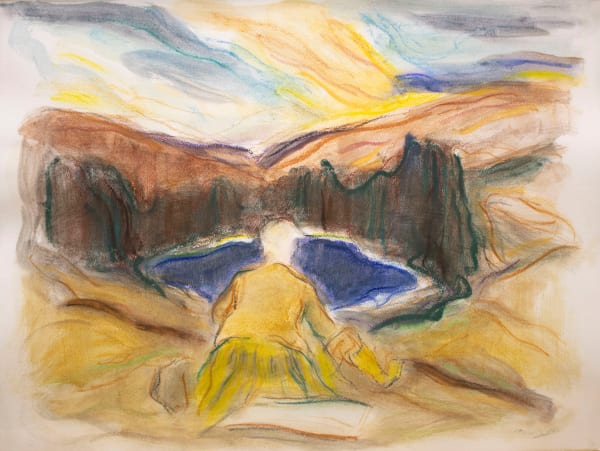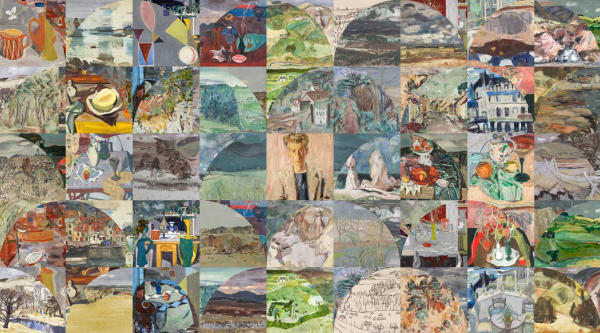-
 Sir William Gillies RSA RA, Landscape with Pink Cloud (detail)
Sir William Gillies RSA RA, Landscape with Pink Cloud (detail) -
 Alexander Moffat RSA, The Dark Pond (detail)
Alexander Moffat RSA, The Dark Pond (detail) -
Sam Ainsley RSA
-
I have long been an admirer of Gillies’ tree drawings and paintings and have become increasingly aware of the correspondences between the veins and arteries in the human body, especially the heart, and the branches and roots of trees.
His beautiful drawings and paintings of trees have fed my own growing obsession with researching every aspect of trees, aesthetically, scientifically, philosophically and especially our emotional connections with them. Two books in particular have also influenced me; one from long ago Memory and Landscape by Simon Schama and more recently The Overstory by Richard Powers, both powerful reminders of the strong hold of trees in the human psyche and their importance to human life.
We still understand little of their interconnectedness with other parts of the natural world including underground spores and the study of mycology, this is often hidden from view but we can at least celebrate their infinite variety and beauty in art.
-
Elizabeth Blackadder
-
Michael Docherty RSA
-
These pieces have been re-worked in the intervening time since my two Gillies Bursary awards which allowed me to travel to North Africa and Cuba. The awards had a huge impact on the development of my work.
I first met Gillies in 1964 when he was the Principal of Edinburgh College of Art. I was just 16 years of age and was not eligible for a Scottish Department Award, but Gillies convinced the Department to give one under exceptional circumstances. I met Gillies on a number of occasions over the years, and was very taken by his charm and modesty. Amazingly, he liked my work! -
George Donald RSA
-
My memories of Gillies date back to my early student days at Edinburgh College of Art, where he was Principal, and still very much involved with students’ painting. I had the privilege at that time, of visiting his home and studio in Temple village. I recall feeling how very familiar the place was, having seen so many of his domestic interiors, window views, and arranged objects in his still life paintings.
Decades later, I too came to live in the Borders, and share his enthusiasm for its extraordinarily varied landscapes; its rivers, woods, its patchwork of fields, heather moors and surrounding hilltops. These small works are my response to the glorious Borders landscape around my home and studio. -
Kate Downie RSA
-
This red-oxide sketch began life in the Glen Lyon and shows a modest wooden bridge over a deep burn that runs to the river. Hidden in the tree shadows is an old fishing bothy. Made in October 2020, I feel this work captures some of the excitement of exploring an unfamiliar landscape after the travel restrictions during Covid times. I was willing to experiment with materials and colour, and I suspect that times spent drawing the Forth Rail Bridge has left me with a deep fondness for red oxide.
William Gillies was a great one for drawing expeditions himself, setting off with fellow artists as a way of healing from the trauma of war: exploring and responding to the natural beauties of this landscape. He too was happy to draw the modest corners, as much as the grand vistas. It was his example, as well as that of Eardley, Redpath and Low, which helped me to stay grounded in my practice as an artist as I developed.
Another great legacy was the posthumous gift of Gillies’ estate to the RSA. I received a small part of this, the William Gillies Bursary, funding my first visit to China in 2010, leading to four subsequent visits up until 2015. There, I studied Chinese Ink painting and applied this technique to Construction of the North Tower, Queensferry Crossing whilst Artist in Residence for the 50th anniversary of the Forth Road Bridge in 2014.
The broad span of Gillies’ oeuvre across 50 years reflects many of the developments of European art at the time but remains very much that of the artist himself, grounded in the Scottish landscape. This strong, unmistakeable identity together with the investigative nature of his approach has been such a good role model for artists coming after him. Most of all, however, it is the joy he clearly felt through the act of creation that reminds me why we choose to be artists. -
Stuart Duffin RSA
-
In 2006 I was granted an Academicians' Gillies Bursary for a research and development residency at Belfast Print Workshop. Whilst there, I commenced work on a suite of six pairs of mezzotint engravings which were completed by 2007. Solus II is a new combination comprising the very first (upper) and last (lower) mezzotint plates from the finished suite and made especially for this exhibition.
Ten years later in 2016, to further develop my research from Belfast, I was again granted an Academicians' Gillies Bursary, this time for a residency at Jerusalem Print Workshop. Although the central mezzotint plate for Time-peace was originally finished in 2017 as a direct result of the Jerusalem residency, I have developed the work specifically for this exhibition by incorporating two new etching plates, updating it to reflect recent global concerns.
William Gillies has left a legacy that inspires and provides for artists in Scotland and the support that I have had from the RSA Gillies Bequest continues to prove vital for my development as an artist and an individual. -
Lennox Dunbar RSA
-
In 1999 I received a Gillies Bursary from the RSA, which allowed me to visit and make new work at the then Printmaking Centre in Santa Fe, New Mexico. Little did I know at the time that this would lead to a long and very positive experience teaching there in their summer school programme, for twenty or so years. Although the focus of this development in my practice was geared towards advancing printmaking processes, the opportunity to visit and explore a different country and culture over an extended period of time had a significant impact to my painting also. My academy diploma work Santa Fe Door was the first of several works which referenced my time spent there.
My paintings in this exhibition reflect the influence that part of the United States has had in my work over a number of years. I hope that the colour and symbolism in these works conveys a connection to that place and its history.
The first time I visited Santa Fe it snowed, and the colour and light which I had expected, was completely the opposite to what I experienced, joyous nevertheless. The painting Winter Screen (Desert) was a response to that unexpected first impression. -
James H. Fairgrieve RSA
-
This quiet, modest yet prolific painter from East Lothian (like me) was a major influence for me and many other Scottish artists over many years, and I very much valued and appreciated his encouragement. A couple of personal memories as a student at ECA spring to mind:
In the early sixties, as a second year student, I submitted a painting done over the summer to the annual ‘Summer Composition’ exhibition held in the spacious and grand Sculpture Court of ECA. As Principal at the time, Gillies did a critique of the show describing my work as ‘poetic’. Not being sure what this meant in a painting context, I was nevertheless thrilled to hear MY work discussed by such a distinguished artist, and took immense encouragement from this.
Years later, as a postgraduate student, with James Cumming RSA as my tutor, I was privileged, along with a few other post grads, to be driven by James Cumming out to Temple village for supper with Gillies – great home made soup, home made elderflower wine, and an evening of encouraging artistic chat! Much later still, as a part time lecturer at ECA, and an ARSA, following the death of Gillies, I was invited by the RSA to spend the summer rummaging through that same cottage in Temple, cataloguing the bequest of work he had left to the Academy. Oils, watercolours, drawings, sketchbooks and objects which featured in the many still lives he produced, were everywhere - under carpets, behind furniture, in portfolios, in cupboards and drawers – I had a memorable summer discovering them! -
Ronald Forbes RSA
-
 Ronald Forbes RSAIndian SummerAcrylic on linenImage: 61 x 46 cm
Ronald Forbes RSAIndian SummerAcrylic on linenImage: 61 x 46 cm
Frame: 71 x 59 cm -
 Ronald Forbes RSAIndian Summer (2)Acrylic on linenImage: 61 x 46 cm
Ronald Forbes RSAIndian Summer (2)Acrylic on linenImage: 61 x 46 cm
Frame: 71 x 59 cm -
 Ronald Forbes RSAIndian Summer (Elephant)ScreenprintImage: 45.5 x 38 cm
Ronald Forbes RSAIndian Summer (Elephant)ScreenprintImage: 45.5 x 38 cm
Frame: 72 x 63 cmEdition of 20 -
 Ronald Forbes RSAIndian Summer (Aeroplane)ScreenprintImage: 45.5 x 38 cm
Ronald Forbes RSAIndian Summer (Aeroplane)ScreenprintImage: 45.5 x 38 cm
Frame: 72 x 63 cmEdition of 20
-
-
William Gillies was principal of Edinburgh College of Art when I started as a student in 1964. As a junior student I did not encounter him on a day-to-day basis, and the first time I met him was at the beginning of my second year. I won a prize in the Summer Comp(osition) exhibition, which was an important part, and the first event, of the ECA annual programme of activities. When presenting the prize, Gillies talked to me with engagement and friendliness about my painting. I have always admired his work, and have been viewing it with pleasure since my student days, when I could see it, fresh off the easel, at the Scottish Gallery, or the RSA Annual Exhibition.
I have been fortunate to have received two awards from the Gillies Bequest. Both resulted in books as the main outcome. The most recent supported the publication about my work authored by Dr Tom Normand HRSA, called A Blind Man’s Dreams: The Paintings and Films of Ronald Forbes. The first award, back in 1999, was to allow me to make my first trip to India. This was a life changing adventure. The outcome was an artist’s book called Indian Summer and this toured with an exhibition of related drawings, prints and paintings to museums and galleries in London, Edinburgh, Stirling, Perth, St Andrews and Dundee over a period of three years. The works here are from that body of work. -
Paul Furneaux RSA
-
 Paul Furneaux RSASt. Ninian Isle, ShetlandPen and ink, pastelImage: 40 x 29 cmSold
Paul Furneaux RSASt. Ninian Isle, ShetlandPen and ink, pastelImage: 40 x 29 cmSold
Frame: 53 x 42 cm -
 Paul Furneaux RSANear Scalloway: Shetland (Dancing Sea)Pencil, watercolour, pastelImage: 29 x 32 cm
Paul Furneaux RSANear Scalloway: Shetland (Dancing Sea)Pencil, watercolour, pastelImage: 29 x 32 cm
Frame: 41 x 43 cm£ 850.00Sold -
 Paul Furneaux RSAHeavy Skies: Shetland (Near Scalloway)Pen and ink, pastelImage: 40 x 30 cmSold
Paul Furneaux RSAHeavy Skies: Shetland (Near Scalloway)Pen and ink, pastelImage: 40 x 30 cmSold
Frame: 53 x 42 cm -
 Paul Furneaux RSAMangaster Beach: Lewis IPen, ink, watercolour, coloured pencilsSold
Paul Furneaux RSAMangaster Beach: Lewis IPen, ink, watercolour, coloured pencilsSold
-
-
From a young age I admired and looked at Gillies drawings, in particular the pen and ink and watercolour. They have an immediacy which has endured through the years. A lot of my earlier work in drawing and painting would begin with drawing in the city or in the landscape. Over the years my work has become more and more studio-based, and more abstracted. However it is necessary for me to have spells where I return to the landscape and sit and draw directly from it. I find the activity helps lock the place deep in my memory. I feel the act of drawing heightens the experience of the landscape in a way which helps to distil this in the studio. These drawings have been made in the islands of Lewis, Orkney and Shetland.
-
John Houston RSA
-
Jane Hyslop RSA (Elect)
-
Having lived in Midlothian all my life and with family connections to the linen mills and farms around Carrington and Redheugh stretching back over several centuries I have a strong affinity with the land and the landscape where Gillies lived and worked for much of his life. This, alongside his important connections with Edinburgh College of Art where I studied and now teach mean that our lives cross paths in numerous ways but at different times.
I have always had an attraction to his work, his love of the same place that I have such a connection to, where I explore, to make work to enjoy and discover. A regular walk takes me on the road to Carrington and when there I always think of his drawings and paintings. Recent drawings have required me to collect plants from the same woods and hedgerows where Gillies painted and having researched his work I came across a watercolour and pencil on paper, The Pentlands, Winter, made in 1950. This scene is similar to a memorable view I often see and the works I have made mark this spot and reference Gillies’ earlier work. -
Henry Kondracki RSA
-
Temple in the Winter
The title of the exhibition is After Gillies which suggests a chronological or psychological investigation. I made a pilgrimage to the village of Temple which is connected to the Knights Templar and I think of William Gillies as a knight protecting the faith of painting; a conduit of all the best in European 20th century art; Bonnard, Klee, Chagall, Munch, Derain et al. All these painters were psychological and optical explorers.Gillies Painting
I placed Gillies in one of his own paintings. Camping out seems to have brought him great joy and I wondered if being in a natural, unblemished landscape was restorative for him after the ravaged landscapes he witnessed in the First World War.Landscape Through the Car Window
I read that Gillies was interested in the internal combustion engine and always had a car or motor bike. I was taught at the Slade by Jeffrey Camp who was taught by Gillies in Edinburgh, and I asked him once what Gillies had taught him. He answered ‘peripheral vision’. In this painting I imagine how Gillies would have experienced the landscape speeding through the countryside in his car. -
Eileen Lawrence RSA
-
In the 1960s Inverleith House in the Royal Botanic Garden, Edinburgh, was home to the collection of the Scottish National Gallery of Modern Art. It was there that I first saw a work by Gillies. It was a small oil painting with the title The Peebles Train painted in 1950. I found this work to be charming and beyond this it had a certain resonance. It was exhibited among other outstanding works by artists as diverse as Alan Davie, Eduardo Paolozzi and Francis Cadell.
I was a student at Edinburgh College of Art from 1963 and had the opportunity to see and hear Gillies speak when as Principal he presented the prizes for the Annual Sketch Club Exhibition. He described the work of another student as ‘poetry in paint’. This phrase seemed to aptly describe Gillies’ own work. I knew the work of the poet Ian Hamilton Finlay and his use of the visual in poetry and Gillies’ reference to poetry in the visual made sense to me.
As an artist Gillies traversed the country responding to the landscape with his unique vision, from the remote, distinctive shape of Suilven standing at 731 metres, to the lower lying moorlands of the Scottish Borders. I have found a particular affinity to his drawings, paintings and watercolours of moorland. His looser sketches often describe this landscape with a few lyrical lines and it is with reference to these that I have selected a work of mine with the title Heathland painted in 2000. A subject I have worked with from the 1970s to the present day. -
Alexander Moffat RSA
-
Leon Morrocco RSA
-
Jim Pattison RSA
-
Barbara Rae RSA
-
Edward Summerton RSA
-
The Landscape Artist
I remember as a youngster listening into a very concerned phone conversation my mother was having about the Council having to cut off my uncle's gas. My uncle was a colourful character to say the least (if sheep black is a colour?), suffering most of his life as an alcoholic. Was he struggling to pay the gas bill, I wondered? Was he going to blow himself up? It was distressing for sure. A few weeks later I was informed that I’d heard wrong. The Council were not having to cut his gas but having to cut his grass! The poor man’s life was in tatters. He’d lost his job. His wife and kids had left him. But the tipping point and apparent shame for my council housing scheme family in Dundee, was not having his gas cut, but having to have his grass cut. What an embarrassment. How could someone let themselves get to this stage?
So here I am now, almost 50 years later, peering out the window, knowing spring is not far off. That the grass will start growing, and I’ll return from a “landscape art trip”, terrified that I can’t start the lawnmower. Broken in the knowledge that I’ll have to get a man in to do it. What an embarrassment. Oh heck. What would Gillies do? Where’s that bottle?Icelandic Drawings
Within every artist there’s a bit of our DNA which harks back to being outside, drawing and painting in nature. Out with ourselves, our studios. 40 years ago, I came across this romantic gesture in a book of Gillies’s work. Not in the reproductions of his paintings, but a small black and white photograph of his canvas ridged tent perched on some hillock. There were paintings draped over the tent frame drying, (I might have imagined this) but do remember thinking about how heavy it looked. Did he have to carry it far? Did it keep out the midges? Did it have a groundsheet?
30 years later, on receiving an RSA Gillies Bursary, I’m travelling across Iceland by bicycle, with a tent. A three-week adventure traversing the rugged west coast, then south back through the interior desert. Continuously drawing outdoors. And when within earshot of a village or campsite, the curious would be attracted to that romantic gesture of the lone artist drawing in nature, and approach. Wondering if I’d manage to capture the colour of the lake, the shape of the rocks or clouds. Every time, an embarrassing and awkward conversation would acknowledge that these three weeks on my own, on a bike, with a tent, had in fact teased out that other kind of DNA. The supplementary stuff that artists tap into. The good stuff. Which unfortunately sends the inquisitive locals, tip-toing backwards across the field. -
Explore further
-

Purchase the new publication
William Gillies: Modernism and Nation in British Art Andrew McPherson Through exploring the life and work of William Gillies, Andrew McPherson shows that his art originates in his personal traumas and awareness of human fragility in a century of world... -

William Gillies
Modernism and Nation on Tour Throughout 2024 and 2025 we are pleased to be taking William Gillies on tour throughout Scotland Throughout 2024 and 2025 we are pleased to be taking William Gillies: Modernism and Nation on tour to nine venues across Scotland. Each venue will have its own unique flavour.
-
After Gillies
Current viewing_room





